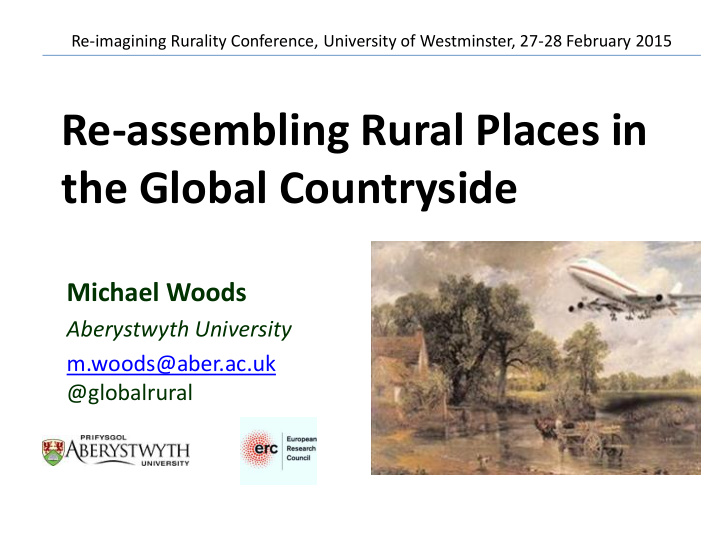



Re-imagining Rurality Conference, University of Westminster, 27-28 February 2015 Re-assembling Rural Places in the Global Countryside Michael Woods Aberystwyth University m.woods@aber.ac.uk @globalrural
Farm (Pryor Creek, Oklahoma) 2015 John Gerrard
Facebook server farm Lulea, Sweden
Goonhilly Downs, Cornwall
“The countryside is in urban hands already, as it has been since the city generated its trade and capital. ” Anthony Barnett (1998) in Town and Country , p. 342 .
Re-imagining the Rural • Shifting scales – The countryside of the city – The national countryside – The global countryside • How do we imagine the rural in the era of globalization? – Rural repositioned “ to serve two new and very different purposes – playground and dumping ground – as the traditional rural economy declines” ( Epp & Whitson, 2001, Writing Off The Rural West , p xv) – Too passive? – Rural actors as active agents in reproducing, negotiating and contesting globalization?
Assemblages “a collection or gathering of things or people” Dictionary definition. “ assemblages are composed of heterogeneous elements that may be human and non-human, organic and inorganic, technical and natural. ” Anderson and McFarlane (2011) in Area , p 124 “The term is often used to emphasise emergence, multiplicity and indeterminacy, and connects to a wider redefinition of the socio-spatial in terms of the composition of diverse elements into some form of provisional socio-spatial formation” Anderson and McFarlane (2011) in Area, p 124
Assemblage Theory
Assemblage Theory • The components of an assemblage have both material and expressive roles • An assemblage is stabilized and destabilized through processes of territorialization and deterritorialization • An assemblage is given an identity through coding and decoding
Assemblage Theory • Assemblages are characterised by ‘relations of exteriority’ • “[The capacities of an assemblage] do depend on a component’s properties but cannot be reduced to them since they involve reference to the properties of other interacting entities” (De Landa, ANPS, p 11) • “a component part of an assemblage may be detached from it an plugged into a different assemblage in which its interactions are different” (De Landa, ANPS, p 10)
Assemblage Theory • Assemblages are dynamic and constantly changing • “this can only ever be a provisional process: relations may change, new elements may enter, alliances may be broken, new conjunctions may be fostered” (Anderson and McFarlane, 2011, p 126)
Places as Assemblages • Chapter of ANPS on ‘cities and nations’ as assemblages: – Buildings as material components – Iconic skylines as expressive components – Territorialization through residential practices – Deterritorialization through gentrification – Interactions between town and countryside as relations of exteriority
Rural Places as Assemblages • Material components: Landscape, buildings, crops, livestock, wildlife, economic commodities • Expressive components: Aesthetic qualities of landscape, ‘rural idyll’, folk culture, emotional attachments, sense of identity • Territorialization: Working the land, family inheritance, administrative boundaries • Deterritorialization: Migration, loss of rural services, amalgamation of municipalities • Coding: Description as ‘rural’, eligibility for rural development programmes, media representations • Decoding: Changing meaning of rurality
Rural Places as Assemblages • Relations of exteriority: – Comparison of rural and urban – Interactions with local towns and the region – Migration flows – Economic transactions – Power relations – Intersections with ‘ translocal assemblages’ Understanding the relational constitution of rural place in the context of change, restructuring and globalization
Assemblages and Globalization • How does globalization transform the material composition of rural places through the introduction, removal, substitution and circulation of material objects including commodities, technologies, crops, financial capital etc.? • How is globalization ‘performed’ in rural space through the behaviours, cultural practices and mobilities of migrants, tourists, entrepreneurs and public officials? What impact does this have on the expressive composition of rural places? • How does the stretching and multiplication of social and economic relations in globalization alter the territorialization of rural place? Are rural places being stretched over more expansive territories?
Assemblages and Globalization • How is the rural discursively constructed as a global space in social, economic and environmental terms? How are these translated to the local level through the coding and decoding of rural places? • How are contemporary rural experiences of globalization historically situated? What are the legacies of earlier global engagements and the resultant assemblages?
Norrland Sweden Wales Newfoundland West of Hebei and Ireland Shandong South of provinces Spain Queensland Tanzania Rio Grande do Sul Hawkes Bay GLOBAL-RURAL project European Research Council Advanced Grant 2014-2019 @globalrural www.globarlruralproject.wordpress.com
Outports of Newfoundland
Expressive components: Isolation, Harsh climate, Resilience, Community Photographs from Candace Cochrane (2008) Outport: The Soul of Newfoundland
Material components: • Landscape • Buildings • Boats • Sea • Fish
Fish as a component with both a material (economic) and an expressive (symbolic) role
Territorialization defined by distance and (in)accessibility
Territorialization of place extending out to sea
New material components reshaping external relations
Encountering the global fisheries assemblage…
Reterritorialization
St John’s Hibernia oil field Alberta tar sands
Re-coding place
Re-assembling Rural Place • An assemblage approach allows us to look in detail at the microprocesses and micropolitics through which rural places are changing • Encompasses cultural and material change • Emphasises the interconnection and interdependency of the rural and the urban, and the local and the global • Recognizes the individuality of rural places
The continuing relevance of the rural and the persistence of rural places…. “Through these entanglements, intersections and entrapments, the experience of globalization changes rural places, but it never eradicates the local. Rather, the networks, flows and actors introduced by globalization processes fuse and combine with extant local entities to produce new hybrid formations. In this way, places in the emergent global countryside retain their local distinctiveness, but they are also different to how they were before . ” Woods (2007) in Progress in Human Geography
Recommend
More recommend